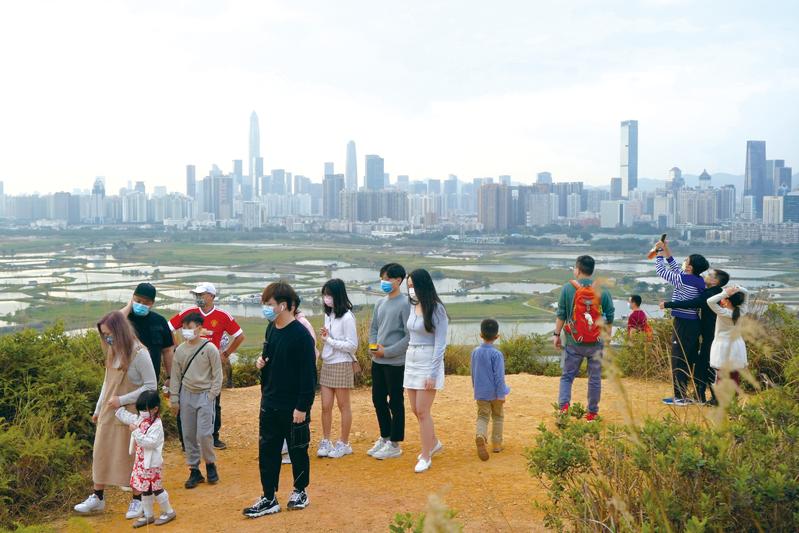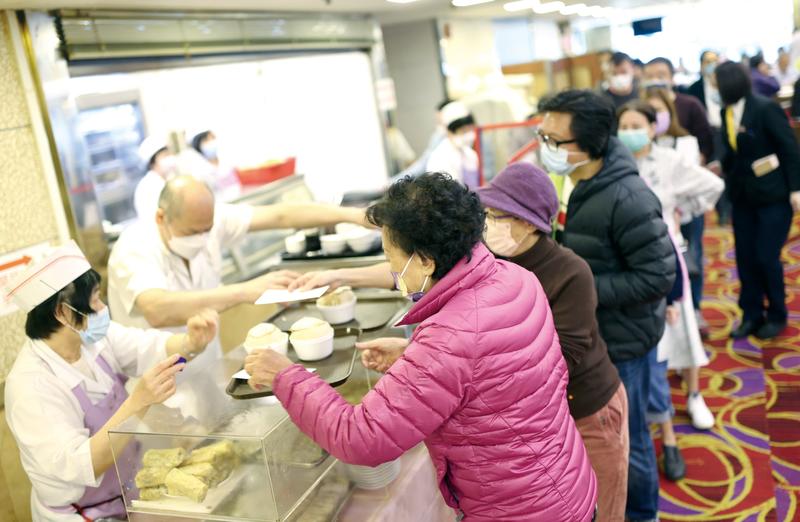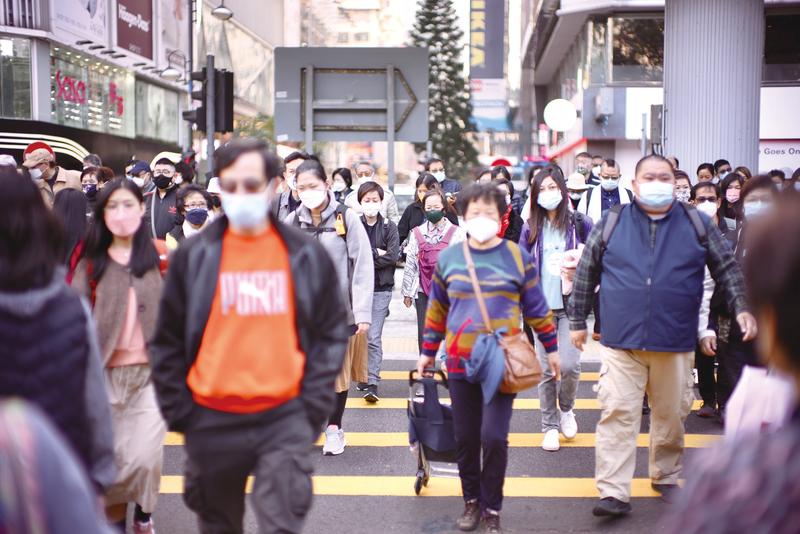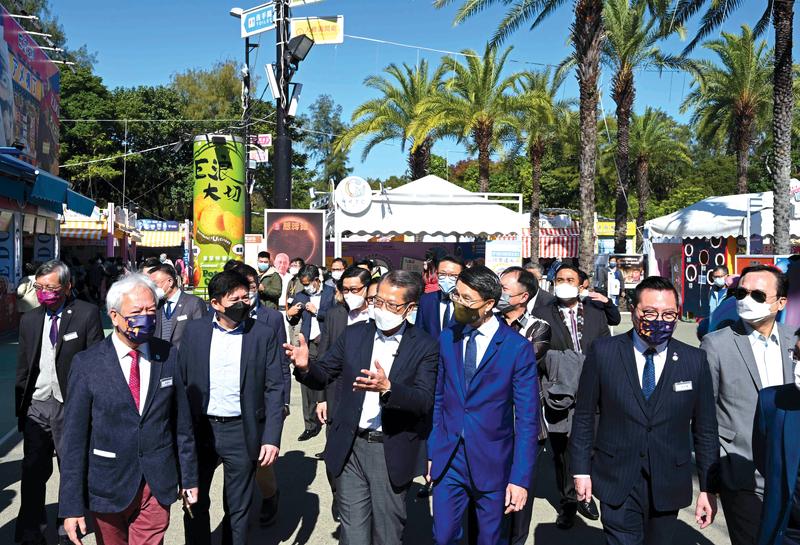Hong Kong’s economy, pillar businesses set to spring back to life as quarantine-free travel between the SAR and the Chinese mainland resumes. Wang Yuke and Su Zihan report.
 Hong Kong hikers look out over the skyline of Shenzhen at the border area near Lok Ma Chau Loop on Feb 13, 2021, about a year after normal travel between the neighboring cities was suspended. (KIN CHEUNG / AP)
Hong Kong hikers look out over the skyline of Shenzhen at the border area near Lok Ma Chau Loop on Feb 13, 2021, about a year after normal travel between the neighboring cities was suspended. (KIN CHEUNG / AP)
Hong Kong’s key businesses are gearing up for New Year with a bang, with the Chinese mainland and the Hong Kong Special Administrative Region resuming normal cross-boundary travel on Sunday after a three-year interruption brought by the COVID-19 pandemic.
The first phase of the full resumption of quarantine-free travel marks a major step in the HKSAR government’s resolve to reboot the local economy, return life to normalcy and restore international faith in the financial and transportation hub’s reopening to the world.
Given the importance of the economic and social connectivity between the Chinese mainland and Hong Kong, the resumption of quarantine-free travel is sure to be welcomed by many international and mainland businesspeople who have been waiting for this good news.
A spokesperson for the Hong Kong Trade Development Council
Jan 8 marked the first stage of restarting normal travel between the mainland and the HKSAR, with 60,000 people per day being allowed to travel each way through seven land, air and sea ports, including four land and sea checkpoints.
Hong Kong has been gradually loosening its COVID-19 travel restrictions since Dec 14, when overseas arrivals who tested negative for the virus were spared the hassle of having to carry an amber health code that barred them from patronizing restaurants, bars, gyms, beauty parlors and other premises that used to be off limits to them.
Hong Kong residents are also no longer required to scan the LeaveHomeSafe digital contact tracing app launched by the government in November 2020 for admission to all public premises, including government and commercial establishments.
Prior to the latest relaxations of the anti-COVID curbs, the government had been rigid and prudent in trying to keep the virus at bay by easing the restrictions step by step — going from complete lockdowns of certain residential buildings, as well as 21-day quarantine for COVID patients, to seven days’ quarantine and to “3+4” (three days of compulsory quarantine at a designated hotel and four days of “medical surveillance”), which was subsequently eased to “0+3”.
While Hong Kong’s daily infection cases are still hovering between 11,000 and 20,000, the authorities have managed to rein in the public health crisis overall. With the local pandemic situation now relatively under control, most of the social distancing measures in place in the past three years have been scrapped, with the exception of the mandatory wearing of masks in public places.
The removal of these restrictions took effect on Dec 22 — Winter Solstice (Dongzhi Festival), one of the most important Chinese festivals celebrated on the Chinese mainland and in Hong Kong, Macao and Taiwan, when people traditionally mark it over a spread of comfort and wholesome food against the chilling weather. It also comes as a boost to the catering sector, helping to rekindle people’s consumption desires.
 Customers wait in line at a dim sum restaurant in Mong Kok, Hong Kong, on Dec 29 after the city lifted most social distancing restrictions, including requiring dine-in customers to provide COVID-19 vaccination records. (EDMOND TANG / CHINA DAILY)
Customers wait in line at a dim sum restaurant in Mong Kok, Hong Kong, on Dec 29 after the city lifted most social distancing restrictions, including requiring dine-in customers to provide COVID-19 vaccination records. (EDMOND TANG / CHINA DAILY)
Consumption rises
However, the SAR government’s determination to keep COVID infections in check has taken a heavy toll on the local economy, with the catering and tourism sectors among the hardest hit.
“It’s now very conducive for all industries to capitalize on the promising business opportunities, beckoning a brisk commercial scene,” says Allen Shi Lop-tak, president of the Chinese Manufacturers’ Association of Hong Kong. He is convinced that renewed hustle and bustle in the consumer market will fast-track the city’s economic recovery.
Holding banquets and social gatherings is a traditional culture among Chinese people during the festive season from the end of December to Lunar New Year, which falls on Jan 22 this year. Businesses are set to make a strong comeback with most of the city’s social restrictions gone. “This scrapping of the curbs means greater convenience and opportunities for business operators and organizers of social events. Thus, the catering industry is bound to pick up,” says Shi.
He noted that the 56th Hong Kong Brands & Products Expo, which ended on Jan 1, was an instant and direct beneficiary, garnering nearly HK$1 billion ($128 million) in sales. “It was the first time in three years that sample tasting of food was allowed on the premises, thanks to the relaxed restrictions on outdoor dining.”
Besides the easing of dining policies indoors, eating and drinking outdoors, such as in places of public entertainment, are now allowed under the Prevention and Control of Disease Ordinance. “To drum up consumption zest, we extended the opening hours during the Christmas and New Year holidays, which attracted many residents,” says Shi.
While acknowledging that the government’s anti-pandemic battle continues to make headway, strengthening business confidence in the process, Shi, however, believes that the local economy and people’s livelihood are unlikely to see a thorough resurrection unless economic collaboration, trade exchanges and tourism between Hong Kong and the Chinese mainland, as well as foreign countries, get back on track speedily.
 A crowded street in Mong Kok, Hong Kong, on Dec 29, as COVID-19 prevention measures were relaxed. (EDMOND TANG / CHINA DAILY)
A crowded street in Mong Kok, Hong Kong, on Dec 29, as COVID-19 prevention measures were relaxed. (EDMOND TANG / CHINA DAILY)
Traveling mood on the high
It might be assumed it’s still too early to expect jaw-dropping and sweeping changes immediately. Travelers’ eagerness to visit Hong Kong has gone up considerably following the lifting of COVID restrictions in the SAR. On Dec 15, Trip.com — one of the world’s largest travel service providers — said it had recorded a more than 2,000-percent spike in searches for flights to Hong Kong, compared with Dec 13, 2021. With more than 400 million users worldwide, the online agency has kept a close tab on travel sentiment since COVID restrictions in Hong Kong were eased.
The top five cities with most people searching for flights to Hong Kong on Dec 13 were Bangkok, Tokyo, Taipei, Seoul and Osaka, registering an increase of between 233 and 908 percent, compared with Dec 6.
A search made on Dec 13 of the world’s cities where most Hong Kong people live to assess the number of people planning to make business trips to the SAR showed a 403-percent increase in Singapore, a rise of 264 percent in Beijing, an increase of 186 percent in Toronto and a spike of 105 percent in London, compared to the previous week. Searches for flights to Hong Kong — as a transit to the Chinese mainland — also recorded an 89-percent increase over the same period.
“We’re optimistic that demand for inbound and outbound travel will continue to go up in the coming months, and this will hasten the travel industry’s recovery,” said Trip.com.
The desire to travel got a shot in the arm after the National Health Commission announced on Dec 26 that the mainland will lift the travel ban, downgrade the level of pandemic management, and remove COVID-19 from its list of quarantineable infectious diseases from Jan 8.
Searches on the number of flights from Hong Kong to the mainland on Trip.com showed a 521-percent increase between 11:30 pm and midnight on Dec 26, compared with the previous week. Shanghai, Beijing, Hangzhou, Chengdu and Nanjing were among the top five most searched-for flight destinations, with Shanghai and Beijing registering the highest growth in the number of searches made — up 1,039 percent and 718 percent, respectively.
In response to expected growing market demand, Trip.com Group is assembling useful overseas destination resources and rolling out outbound tourism products and services, according to Edison Chen, the group’s general manager for destination marketing.
“The tourism industry has been waiting for this for a long time, and is a crucial step toward the full resumption of travel in Hong Kong and the opening-up of tourism,” said Perry You Pak-leung, who represents the tourism sector in the Legislative Council.
He said the tourism business has been going through a tough period amid the three-year-long pandemic. It needs the government’s continued attention and support. He proposed setting up a rehabilitation fund to help the entire industry chain make a full recovery.
“Hong Kong has been slow, compared with other popular Asian tourist destinations, in opening up post-COVID. It’ll take time for the city to regain its status as an international aviation hub,” said Yiu.
The lawmaker urged the SAR government to step up external publicity efforts to rebuild the city’s reputation, saying Hong Kong should be well-prepared to welcome tourists within the shortest possible time frame, helping to revive its tourism business, and enable its economy to take off again.
 Financial Secretary Paul Chan Mo-po (fourth right), together with consuls general from five countries of the Association of Southeast Asian Nations in Hong Kong, visits the 56th Hong Kong Brands and Products Expo at Victoria Park on Dec 22. (PHOTO PROVIDED TO CHINA DAILY)
Financial Secretary Paul Chan Mo-po (fourth right), together with consuls general from five countries of the Association of Southeast Asian Nations in Hong Kong, visits the 56th Hong Kong Brands and Products Expo at Victoria Park on Dec 22. (PHOTO PROVIDED TO CHINA DAILY)
Renewed vigor in key areas
Shi says the government’s efforts will facilitate the holding of major fairs, exhibitions and other international events or recreational activities in Hong Kong.
More than 30 B2B (business-to-business) conventions secured by the Hong Kong Tourism Board are expected to be staged in the city over the next three years. They cover a wide spectrum of themes, such as business management, aviation, science and technology, and healthcare, with some of the events making their debut in Hong Kong. “It’s a strong testament to the city’s status as the ‘world’s meeting place’,” HKTB officials said.
“Given the importance of the economic and social connectivity between the Chinese mainland and Hong Kong, the resumption of quarantine-free travel is sure to be welcomed by many international and mainland businesspeople who have been waiting for this good news. The unimpeded flow of international and mainland travelers will also benefit the convention and exhibition sector,” said a spokesperson for the Hong Kong Trade Development Council.
The council has lined up a full program of business events this year to help companies seize the opportunities on offer, including the Asian Financial Forum, the Hong Kong International Wine & Spirits Fair, the Houseware Fair, and the International Healthcare Week.
Hong Kong insurers are also gearing up for more business from mainland visitors.
The city’s life insurance industry is set to register compound annual growth rate of 3.5 percent in direct written premiums — increasing from HK$500.3 billion in 2023 to HK$573.5 billion by 2026 — driven by positive economic developments and the lifting of international travel restrictions, says GlobalData, a leading data and analytics company.
“Mainland residents are a prominent consumer segment for Hong Kong life insurers as life insurance products available to them in Hong Kong offer greater flexibility and higher returns,” says Sravani Ampabathina, an insurance analyst at GlobalData. Noting the 110-percent growth in new business from mainland customers in the first nine months of last year in response to the relaxed travel restrictions, he believes the upward trend will continue.
Prudential Hong Kong has been preparing for the sector’s recovery in the past few months, ensuring that all its services, sales channels, platforms and systems are in place, said Lawrence Lam Chi-kong, CEO of Prudential Hong Kong.
The insurance company plans to hire an additional 2,000 financial advisers this year to attend to its growing local businesses, as well as overseas operations, to meet increased business needs.
Lam believes that the resumption of tourism with the mainland will further revitalize Hong Kong’s economy and benefit the city’s insurance industry.
According to HSBC Insurance, about 40 percent of new premiums came from mainland customers before the pandemic. It expects business from mainland visitors to return to pre-pandemic levels following the lifting of the travel ban.
 Hong Kong passengers put their bags into the luggage compartment of a cross-boundary bus leaving for the Chinese mainland on Sunday, the day that quarantine-free travel resumed between the SAR and the mainland. (ANDY CHONG / CHINA DAILY)
Hong Kong passengers put their bags into the luggage compartment of a cross-boundary bus leaving for the Chinese mainland on Sunday, the day that quarantine-free travel resumed between the SAR and the mainland. (ANDY CHONG / CHINA DAILY)
Talent’s lack of confidence
The suspension of normal travel between Hong Kong and the mainland in the past three years has battered the tourism industry, impeded the flow of talent, and taken a toll on Hong Kong’s already shrinking labor market due to a huge talent exodus. Between mid-2021 and mid-2022, 113,200 people emigrated, slashing Hong Kong’s population by 1.6 percent -- equivalent to an average daily loss of 310 people. Tough anti-pandemic measures have disillusioned a bevy of professionals who had moved to Hong Kong to further their careers.
According to Tina Cheng, senior director of business strategy at Midland Immigration Consultancy, there’s a backlog of roughly 10,000 Quality Migrant Admission Scheme applications that were left unapproved in 2020 and 2021 due to disruptions caused by the pandemic.
She said she believes the resumption of quarantine-free travel between the mainland and the HKSAR, perceived to be long overdue, is set to rekindle professionals’ interest in developing their careers in Hong Kong. Hong Kong’s policies to attract talent and enterprises, including the launch of the Top Talent Pass Scheme this year, will see 45,000 potential professionals heading to the city, Cheng predicts.
Contact the writers at jenny@chinadailyhk.com


